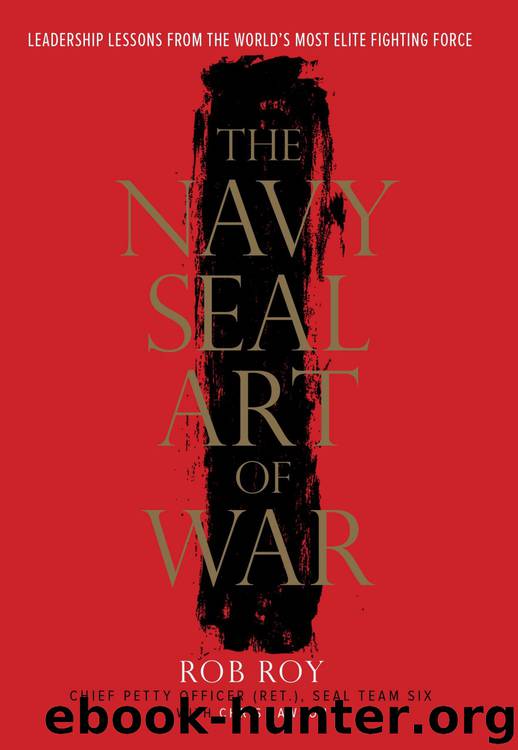The Navy SEAL Art of War: Leadership Lessons from the World's Most Elite Fighting Force by Rob Roy & Chris Lawson

Author:Rob Roy & Chris Lawson [Roy, Rob]
Language: eng
Format: epub, mobi, azw3
ISBN: 9780804137751
Publisher: The Crown Publishing Group
Published: 2016-04-12T16:00:00+00:00
VINCENT: Who taught you?
SAM: I don’t remember. That’s the second thing they teach you.
In our case, feel free to remember Geoff as your teacher. And remember to trust your gut.
OPTIONS, ULTIMATUMS, AND VERSATILITY
ONE OF THE COVERT and clandestine ways that SEALs descend upon a target is by submarine. Nothing is as invisible and undetectable as a nuclear-powered fast-attack or missile sub hovering off the coast of some unsuspecting foreign country. And when necessary, nothing can better unleash America’s lethal power than these unseen monsters of the deep. For SEALs, insertion by sub is as stealthy as it gets.
It’s also a testament to our raison d’être: versatility.
Over the years, we have perfected our submarine insertion options. One of the most common—and unclassified—methods utilizes what we call a Dry Deck Shelter, or DDS, which is mounted onto the back of a submarine, behind the sail. In essence, the DDS is a thirty-eight-foot long, removable, spherical, submersible garage that holds SEAL toys, including our own minisubs known as Mark 8 Swimmer Delivery Vehicles, or SDVs, and our Combat Rubber Raiding Craft. Thanks to lockout trunks and multiple hyperbaric chambers, the DDS also allows us easy entrance to and exit from the submarine. (You can see videos of these assets on Navy-sponsored websites and YouTube channels. Just Google it.)
On many a mission, including during Operation Desert Storm, as well as on many a training exercise, I donned scuba gear and left the warm, dry confines of a submarine for the cold, dark ocean depths via a flooded DDS. Well below the ocean surface, my teammates and I would open the DDS’s “garage doors” and remove our twenty-one-foot SDVs—either breathing from our own oxygen tanks or by using the vehicles’ compressed-air supply. One SEAL would serve as the SDV pilot, another as copilot, and the rest of us made up the combat swimmer team. We all rode along on what we affectionately called “the sled.”
Depending on how close the submarine can safely hover offshore, it can take hours for the SEAL teams to travel to their targets. Once there, we either conduct direct action or surveillance operations. When my teammates and I attacked Iraqi oil platforms during the Persian Gulf War, for example, it took hours for us and our SDV to make our way from the submarine to the target. But once there, we quietly anchored the SDV to the ocean bottom and swam to the platforms, making unannounced appearances that to the Iraqis must have seemed like we materialized via a Star Trek–like transporter. We later jumped back into the black water and, untethering the sled, drove it back to the waiting sub.
That kind of versatility is a huge force multiplier. SEALs never stop trying to adapt and innovate existing capabilities to tackle new and unseen challenges. For instance, the Navy continues to develop plans for next-generation underwater delivery systems that can improve the combat capability of SEAL forces. An Advanced SEAL Delivery System (ASDS) was built and launched in 2003 after years of study.
Download
The Navy SEAL Art of War: Leadership Lessons from the World's Most Elite Fighting Force by Rob Roy & Chris Lawson.mobi
The Navy SEAL Art of War: Leadership Lessons from the World's Most Elite Fighting Force by Rob Roy & Chris Lawson.azw3
This site does not store any files on its server. We only index and link to content provided by other sites. Please contact the content providers to delete copyright contents if any and email us, we'll remove relevant links or contents immediately.
| Bookkeeping | Business Mathematics |
| Business Writing | Communications |
| Decision Making | Negotiating |
| Project Management | Running Meetings & Presentations |
| Secretarial Aids & Training | Time Management |
| Training |
Nudge - Improving Decisions about Health, Wealth, and Happiness by Thaler Sunstein(7660)
Deep Work by Cal Newport(6970)
Principles: Life and Work by Ray Dalio(6299)
The Doodle Revolution by Sunni Brown(4717)
Factfulness: Ten Reasons We're Wrong About the World – and Why Things Are Better Than You Think by Hans Rosling(4715)
Eat That Frog! by Brian Tracy(4484)
Thinking in Bets by Annie Duke(4186)
Hyperfocus by Chris Bailey(4088)
Visual Intelligence by Amy E. Herman(3753)
Writing Your Dissertation in Fifteen Minutes a Day by Joan Bolker(3699)
Ogilvy on Advertising by David Ogilvy(3557)
Hidden Persuasion: 33 psychological influence techniques in advertising by Marc Andrews & Matthijs van Leeuwen & Rick van Baaren(3522)
How to Win Friends and Influence People in the Digital Age by Dale Carnegie & Associates(3521)
How to win friends and influence people by Dale Carnegie(3440)
The Pixar Touch by David A. Price(3392)
Schaum's Quick Guide to Writing Great Short Stories by Margaret Lucke(3348)
Deep Work: Rules for Focused Success in a Distracted World by Cal Newport(3185)
Work Clean by Dan Charnas(3081)
The Slow Fix: Solve Problems, Work Smarter, and Live Better In a World Addicted to Speed by Carl Honore(2979)
